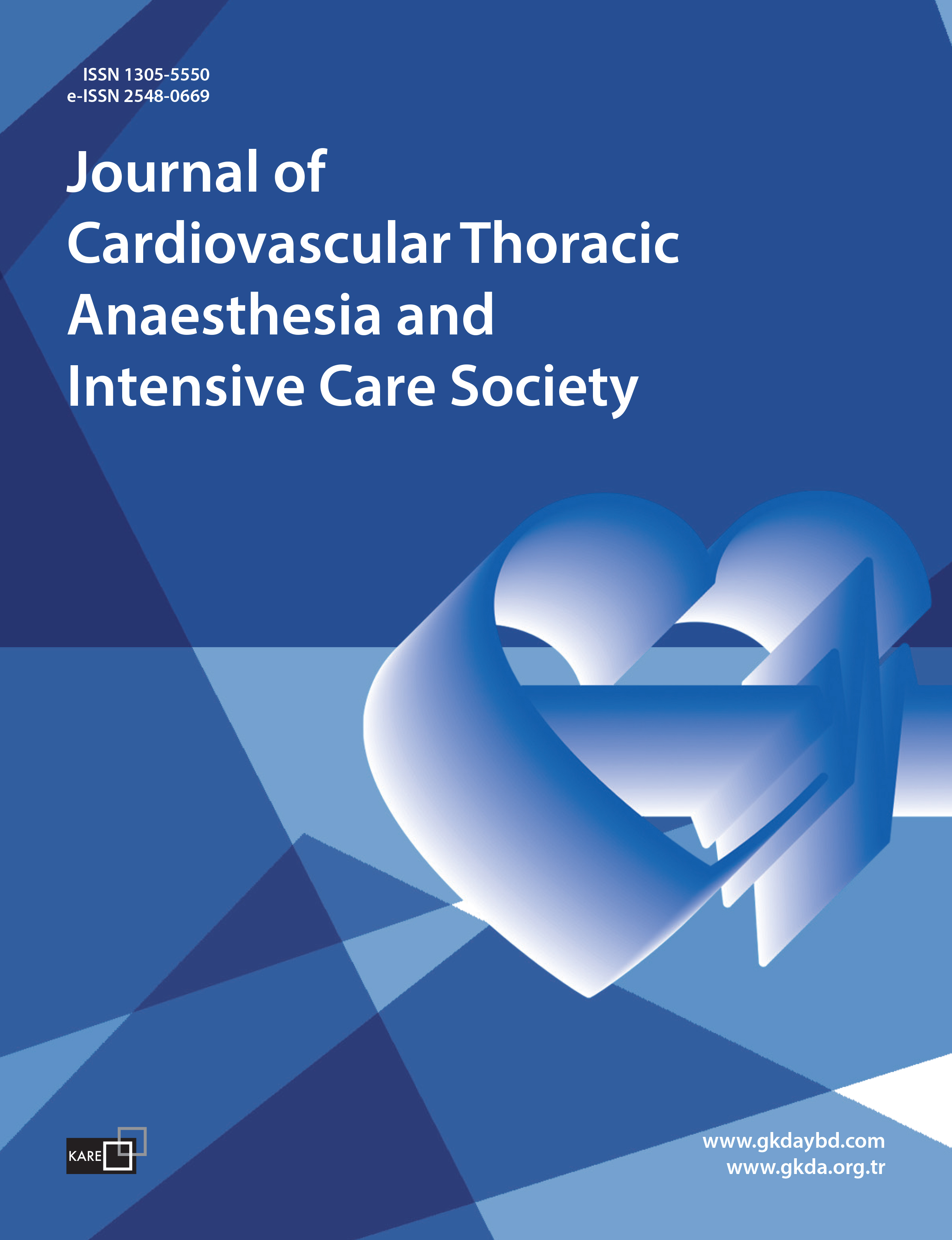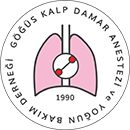

Volume: 20 Issue: 4 - 2014
| REVIEW | |
| 1. | How to Make Risk Scoring In Percutaneous Cardiac Procedures? Elvin Kesimci, Fevzi Toraman doi: 10.5222/GKDAD.2014.189 Pages 189 - 194 (1362 accesses) Risk, which means hazard, danger, exposure to mischance or peril in dictionary; is a measure of probability by statistical chance of usually undesirable future occurrence. Risk stratification is of vital importance not only in carrying out day to day successful anesthetic practice; but is also essential for development of standard procedure guidelines and/or protocols. By risk scoring, the patients are well informed and thus patient consent forms are well qualified. Validated risk models provide standardization between hospitals and surgical procedures. A functional and accurate risk model means a successful plan and beneficial usage of sources. In this context, the use of risk scores gives us objective data to predict postoperative mortality and the patients situation. In this review, specific points to take into considerations; in the evaluation period of patients who are assumed as high risk patients for conventional cardiac valve surgery and are thus candidates for percutaneous cardiac procedures, and risk algorithms are reviewed in the aspect of literature, evidences and suggestions. |
| EXPERIMENTAL WORK | |
| 2. | Effects of Sevoflurane and Desflurane on Myocardial Protection in Comparison with Propofol in Coronary Bypass Surgery Esin Erdem, Belkıs Tanrıverdi, Dilek Ceyhan doi: 10.5222/GKDAD.2014.195 Pages 195 - 201 (1128 accesses) OBJECTIVE: The aim of this study is to compare with myocardial protective effects of sevoflurane and desflurane and myocardial protective effects of propofol via markers of myocardial injury in cardiopulmoner bypass graft surgery (CPB). METHODS: After induction of general anesthesia with etomidate 0.3 mg/kg, a bolus dose of pancuronium 0.1 mg/kg was administered. For the maintenance of anesthesia, patients received either Group S: sevoflurane (n: 20) at 2-4%, Group D: desflurane (n: 20) at 7-8 % and Group K: propofol 50 µgkg-1 dk-1. Arterial blood samples were obtained as follows: before induction of anesthesia, after aortic unclamping, at postoperative 2nd hour and 24th hours. Troponin I, creatine kinase (CK) and creatine kinase-MB (CKMB) values were measured in all obtained samples. In addition arterial blood samples were obtained after aortic unclamping, after aortic unclamping and after protomine infusuion, malonil dialdehyde (MDA) was measured. RESULTS: No statistically significant difference was found among the groups with respect to demographic characteristics, number of grafts, CPB pump duration. Troponin I and CK levels of all groups were increased after aortic clamp placement, at postoperative 2nd and 24th hours. However these increases were not statistically significant. Also, there was no significant increase of MDA level measurements on all groups. Kreatinin kinaz MB levels of all groups were increased postoperative 2nd and 24th hours but this increase in sevoflurane group is lesser than in propofol and desflurane groups. CONCLUSION: Sevoflurane, desflurane and propofol have similar cardioprotective characteristics. |
| 3. | Our Anesthetic Experiences in Patients Undergoing Transcatheter Aortic Valve Implantation by Local Anesthesia and Sedation Ali Çiftçi, Elvin Kesimci, Tülin Gümüş, Ezgi Erkılıç, Neşe Kurtulgu, Ayça Özcan, Orhan Kanbak doi: 10.5222/GKDAD.2014.202 Pages 202 - 208 (1618 accesses) OBJECTIVE: Transcatheter aortic valve implantation (TAVI) has emerged as a new therapy in aortic stenosis patients with high operative risk. Advances in experiences might lead the choice of local anesthesia and sedation for these patients. We evaluated the perioperative anesthetic experiences of patients undergoing TAVI by local anesthesia and sedation. METHODS: Seventy-two (40 male-32 female, with an average age of 77,4±8,7) symptomatic, aortic stenosis patients undergoing TAVI procedure by local anesthesia and sedation, between June 2011 and January 2014 were evaluated retrospectively in the aspect of anesthetic issues. RESULTS: The mean EuroSCORE and STS values of patients were 12 and 6,7 retrospectively. The duration of the procedure was 90 minutes, while sedation time lasted 120 minutes. 16,7 % of the patients required to have general anesthesia. Length of stay in Intensive Care Unit was 2,5 days, while it was 6 days for hospital stay. Thirty day mortality rate was 9,7%. Six patients had vascular complications. CONCLUSION: TAVI, applied in high risk population has many challenges for anesthesiologists by its own risks, also. Herein, the aim is to provide stable hemodynamics. By advances on transfemoral TAVI, it can be achieved under sedation with more stable hemodynamics, less inotropic and vasopressor agents, no endotracheal intubation or mechanical ventilation, thus shortens the length of stay in hospital. In conclusion, research on safer and more effective anesthesia management has still being developed. As a result of these, success in sedation and local anesthesia applied to this high risk patient group will increase. |
| 4. | Investigation of Malnutrition Rates and Related Risk Factors in Open Heart Surgery Hakan Bayır, Ümit Yaşar Tekelioğlu, Hasan Koçoğlu, Akcan Akkaya, Abdullah Demirhan, Murat Bilgi, Kemalettin Erdem, Bahadır Dağlar, İsa Yıldız doi: 10.5222/GKDAD.2014.209 Pages 209 - 214 (1248 accesses) OBJECTIVE: Rates of malnutrition in hospitalized patients may vary depending on the type of hospital and patient population. Malnourished patients have higher mortality and morbidity rates, longer length of hospital stay (LOS) and much more drug use than patients without malnutrition. We aimed to investigate rates of malnutrition in hospitalized patients undergoing open heart surgery and the associated risk factors. METHODS: We studied 50 ASA II-III patients aged between 40-85 undergoing elective open heart surgery. Patients whose NRS-2002 score ≥ 3 and/or, Body Mass Index (BMI) <18.5 kg/m2, and/or serum albumin level <3 g / dl were evaluated as malnourished. Preoperatively patients demographic datas, preoperative left ventricular ejection fraction (LVEF), and values of pulmonary function tests (FVC, FEV1, FEV1/FVC), hemoglobin, hematocrit, lymphocyte count, albumin, CRP, and cholesterol values were recorded. LOS in intensive care unit and service, type of complications that occurred during hospitalization were recorded. Values of Pulmonary function tests were also obtained on the day patients discharged. RESULTS: Malnutrition rate was 20 % in patients with open-heart surgery. Patients at risk of malnutrition had longer postoperative intubated time, LOS in ICU and in service, higher rates of postoperative complications and lower preoperative and postoperative FEV1, FVC, and FEV1/FVC values than those without risk of malnutrition. But these findings were not statistically significant. In addition, LOS in the ICU and service were found longer in overweight and obese patients than others. CONCLUSION: In summary, a high rate of malnutrition can be observed in patients with open-heart surgery. Malnutrition has negative postoperative effects in these patients. |
| REVIEW | |
| 5. | Experience with Double Lumen Tube Application in Difficult Airways Demet Altun, Nükhet Sivrikoz, Gülay Kır, Zerrin Sungur, Ali Emre Çamcı doi: 10.5222/GKDAD.2014.215 Pages 215 - 219 (2536 accesses) One lung ventilation is indicated for certain in videoscopic lung surgery while improving the comfort and quality of surgical procedure but complicate anesthesia. This problems cover wide range from physical problems as placement of the tube and losing their place to gas exchange problem during one lung ventilation. In addition, with abnormal airway anatomy and expected/unexpected difficult tracheal intubation with a double-lumen tube placement can be extremely difficult. In this case we were transferring experiences double-lumen tube placement during videoscopic lung surgery in three patients with expected difficult airway. |
| CASE REPORT | |
| 6. | Our Anesthetic Management in a Patient with Bilateral Carotis Lesions Who is Undergoing Coronary Artery Bypass Graft Surgery Murat Aksun, Nagihan Karahan, Kamil Aşar, Ufuk Yetkin, Işıl Coşkun Musaoğlu, Naciye Pamukçu, Ali Gürbüz doi: 10.5222/GKDAD.2014.220 Pages 220 - 224 (1219 accesses) There is not a consensus in the surgical treatment in patients with carotis stenosis and coronary artery disease. There are some centers which defend the combination of coronary artery bypass graft (CABG) surgery and carotid endarterectomy (CEA) at the same time and also there are some other centers which apply stage therapy. In this case we aimed to report our anesthetic management in patient undergoing CEA with deep and superficial cervical plexus block and subsequently CABG in different sessions. |
| 7. | Transesophageal Echocardiography in a Patient with Chronic Type B Aortic Dissection Treated with Thoracic Endovascular Aortic Repair Hasibe Gül Baytan, Oben Baysan, Gülser Günaydın, Bilge Tuncer, Alper Tosya, Tahsin Edgüer, Tayfun Aybek doi: 10.5222/GKDAD.2014.225 Pages 225 - 228 (988 accesses) Thoracic endovascular aortic repair (TEVAR) is a viable alternative to open surgical repair in patients with descending thoracic aneurysm. Besides computerized tomography (CT) scanning and magnetic resonance imaging (MRI), intraoperative imaging with TEE is mandatory for better delineation of aortic pathology for confirming guide wire placement in true lumen, checking graft positioning, detecting procedure-related complications and follow-up(1). Therefore, an anesthesiologist has an important role in providing these data to the endovascular team. |
| 8. | Ultrasound-guided Radial Artery Cannulation in Intensive Care Unit: Case Series Ümit Yaşar Tekelioğlu, Abdullah Demirhan, Tarık Ocak, İsa Yıldız, Hakan Bayır, Adem Deniz Kurt, Hasan Koçoğlu doi: 10.5222/GKDAD.2014.229 Pages 229 - 231 (1275 accesses) Intra-arterial catheterization is used for continuous pressure monitoring and blood gas analysis in intensive care units. Especially it is used routinely in patients that take inotropic agents. Radial artery is frequently preferred because of adequate collateral circulation and easy cannulation. During this procedure, complication and failure risk is high. Catheterization may lead to complications such as peripheral neuropathy and cerebral embolization which can increase morbidity and mortality. Ultrasonography [USG] guided arterial cannulation can prevent potential complications with an increased success. In this report, we aimed to present the USG- guided catheterization of radial artery in intensive care patients. |
| 9. | Fentanyl Reaction in a Parkinsonian Patient Receiving Monoamine Oxidase Inhibitor while Undergoing Cardiac Surgery Tülün Öztürk, Cengizhan Çıkrıkcı, Funda Yıldırım, Adnan Taner Kurdal, Melek Çivi doi: 10.5222/GKDAD.2014.232 Pages 232 - 235 (1439 accesses) Use of fentanyl is a controversial issue because of possible adverse drug interactions in patients using monoamine oxidase inhibitors during cardiac surgery procedure. In this case report we described a drug interaction with fentanyl in a parkinsonian patient who was 57 years old, 45 kg weigh and required mitral valve replacement surgery while he was taking a selective inhibitor of monoamineoxidase type B (Rasajilin) with selective serotonin reuptake inhibitor (paroxetin). Despite anesthesia and surgery was continued normally, supraventricular tachycardia, hypertension, sweating, flushing and hypertermia was observed during warming of the heart and the weaning period of cardiopulmonary bypass. Tachycardias were treated by cardioversion and beta blocker therapy. The temparature was controlled at 37 oC by using pump perfusion. Fentanyl infusion was discontinued. After hemodynamic stability was achieved, cardiopulmonary bypass was terminated. Total fentanyl consumption was 2,8 mg. Parkinsons therapy was resumed at the first day postoperatively. Patient was discharged at the 7th day. |
| 10. | Cardiac Surgery and Anaesthesia Without Blood Transfusion in 2 Jehovahs Witness Patients Muharrem Koçyiğit, Elif Akpek, Ahmet Ümit Güllü, Şahin Şenay, Cem Alhan doi: 10.5222/GKDAD.2014.236 Pages 236 - 240 (1682 accesses) Cardiac surgery is commonly associated with heavy blood loss and high transfusion requirements on the basis of varieties in surgical types, their being major surgeries, use of cardiopulmonary bypass and institutional differences in the technique, high risk intensive care management and the probability of surgical revision. Cardiac operations consume as much as 10% to 15% of the nations blood supply, and evidence suggests that this fraction is increasing, largely because of increasing complexity of cardiac surgical procedures. Jehovah's Witnesses do not accept blood or blood products under any circumstances on the basis of their beliefs. Therefore, blood conversation strategies are important in Jehovah's Witnesses who are planned to have cardiac surgery. In this report, we present our experiences in two Jehovah's Witnesses who underwent aort valve replacement and redo coronary artery bypass greft surgery, and we wanted to review the blood conversation strategies in our center. |
| 11. | Anesthesia Management of a Child With Scimitar Syndrome Ahmet Selim Özkan, Mahmut Şahin, Ali Karademir, Mustafa Said Aydoğan, Mahmut Durmuş doi: 10.5222/GKDAD.2014.241 Pages 241 - 244 (1220 accesses) Scimitar syndrome (SS) is uncommon complex congenital cardiopulmonary anomaly defined by a partial anomalous pulmonary venous return into the inferior vena cava or right atrium incorporated with right lung hypoplasia, cardiac dextroposition and a systemic right pulmonary arterial supply from the systemic circulation. SS is a rare variant of anomalous pulmonary venous return occurring in 2/100000 live births. Diagnosis is suspected on a chest radiograph demonstrating a arched vascular shadow of the anomalous pulmonary vein descending towards the diaphragm along the right side of the heart (scimitar sign). In these patients, cardiac problems added to respiratory problems makes it important in the anesthetic management of patients.In this case, we aimed to present the anesthetic management and postoperative complications of emergency bronchoscopy in pediatric patient with scimitar syndrome. |

















